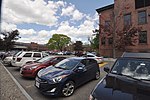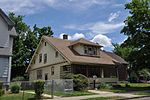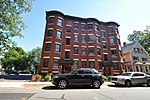Wigglesworth Building (Springfield, Massachusetts)
Apartment buildings in Springfield, MassachusettsApartment buildings on the National Register of Historic Places in MassachusettsNational Register of Historic Places in Springfield, Massachusetts

The Wigglesworth Building is a historic apartment house at 77 Lillian Street and 23 Oak Street in Springfield, Massachusetts. Built in 1917, it is a good local example of Colonial Revival architecture, typifying the city's multiunit construction after the introduction of new building codes. It was listed on the National Register of Historic Places in 2020.
Excerpt from the Wikipedia article Wigglesworth Building (Springfield, Massachusetts) (License: CC BY-SA 3.0, Authors, Images).Wigglesworth Building (Springfield, Massachusetts)
Lillian Street, Springfield
Geographical coordinates (GPS) Address Nearby Places Show on map
Geographical coordinates (GPS)
| Latitude | Longitude |
|---|---|
| N 42.108611111111 ° | E -72.573888888889 ° |
Address
Lillian Street 7
01105 Springfield
Massachusetts, United States
Open on Google Maps








